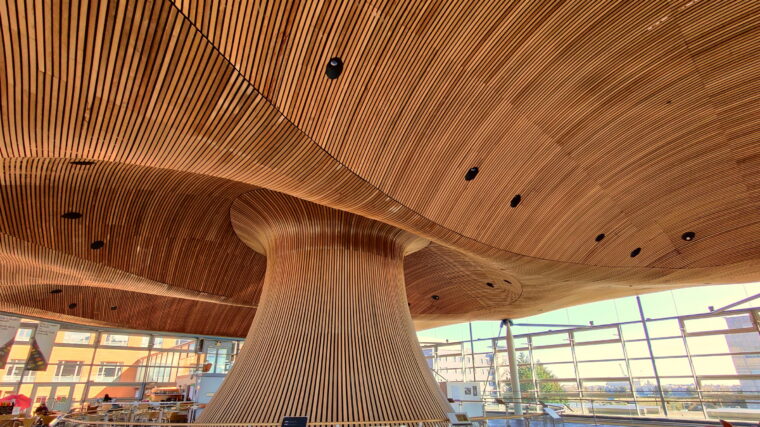The current state of UK higher education in 2025 is marked by an existential crisis, rather than merely a series of difficult challenges.
This crisis comes from the inherent tension of attempting to operate a 20th century institutional model within the complex realities of the 21st century. This strain is exacerbated by complex socio-economic difficulties facing students, coupled with the immense pressures experienced by staff.
A city under siege
Conceptualising UK HE as a “city”, it becomes evident that while valuable as centres of learning, community and potential, this “city” is currently under siege and there is a “dragon at the gates”. The “dragon” represents a multifaceted array of contemporary pressures. These include, but are not limited to, funding reductions, evolving regulatory demands and the escalating cost-of-living crisis. Empirical research indicates that the cost-of-living crisis profoundly impacts students’ capacity for engagement.
Furthermore, this “dragon” is continuously evolving. With the rapid ascent of artificial intelligence (AI) and the distinct characteristics of Gen Z learners representing two of its newest and most salient “heads”. While AI offers opportunities for personalised learning, simultaneously, it presents substantial challenges to academic integrity and carries the risk of augmenting student isolation if not balanced with human connection. Concurrently, Gen Z learners have learned a state of “continuous partial attention” through constant exposure to multiple information streams. This poses a unique challenge to pedagogical design.
Defence, survival and the limits of future-proofing
In response to these multifaceted challenges, the prevalent institutional instinct is to defend the city. This typically involves retreating behind existing structures, consolidating operations, centralising processes, tightening policies and intensifying reliance on familiar metrics such as Key Performance Indicators (KPIs), National Student Survey (NSS) action plans, attendance rates and overall survey scores.
However, survival mode often means the sacrifice of genuine student engagement. This refers not to the easily quantifiable forms of engagement, but the relational, human dimension, wherein students develop a sense of belonging, perceive their contributions as meaningful and feel integrated into a valuable community. Research consistently demonstrates that this sense of belonging is paramount for psychological engagement and overall student success. Consequently, an exclusive focus on defending established practices, reliant on systemically imposed metrics, risks reinforcing barriers that actually impede connection, wellbeing and the institutional resilience that is critically needed.
While the concept of “future-proofing” is often invoked, it is imperative to question the feasibility of achieving perfect preparedness against unknowable future contingencies.
Attack strategies
Given the limitations of a purely defensive stance, a different strategic orientation is warranted: a proactive “attack” on the challenges confronting HE. Genuine engagement should be reconceptualised not merely as a student characteristic, but as an institutional design choice. Institutions cannot expect students to arrive with pre-existing engagement; rather, they must actively design for it.
This proactive engagement strategy aligns precisely with the University of Cumbria’s commitment to people, place, and partnerships. These themes are woven through the university’s new learning, teaching and assessment plan, providing a framework for institutional pedagogic transformation.
Relationships as the bedrock of community
The “citizens” of our HE “city” – students and staff – constitute its absolute bedrock. Strong relationships between these stakeholders are fundamental to fostering a resilient academic community. A critical institutional challenge lies in ensuring that existing systems, policies and workload models adequately support these vital connections. It is imperative to grant staff the requisite time, flexibility and recognition for their crucial relational work. This represents a shift in focus from a transactional interaction to a relationship-centric approach.
Understanding the distinct experiences of diverse groups of students (e.g. apprentices, online learners and commuter students) is of critical importance for building meaningful and authentic engagement. Fundamentally, ensuring that students feel “seen, heard and valued” is a key determinant of psychological engagement and a prerequisite for all other forms of learning to take root.
Designing for inclusive environments
The concept of “place” encompasses the entire physical and digital environment of the HE institution. Belonging, rather than being an abstract sentiment, possesses a strong spatial and environmental dimension. For institutions like the University of Cumbria, intentional design of consistent environments that cultivate a sense of “This is my place” is paramount. An important tactic in this regard is to build belonging by design, particularly at critical transition points such as induction.
This notion of “place” is particularly vital for commuter students, who often lack the built-in community afforded by residential halls. For this cohort, the physical campus serves as the primary site of their university experience. A critical assessment of their campus experience between scheduled classes is needed. Are institutional spaces designed to encourage students to remain, study and connect? When students choose to utilise them, these spaces facilitate spontaneous conversations, the formation of friendships, and the organic development of belonging.
This kind of intentionality is required for digital learning environments. Are virtual learning environments (VLEs) merely content repositories, or are they designed as welcoming community hubs? The creation of inclusive, supportive environments – both physical and virtual – where students feel genuinely connected, is absolutely fundamental to effective engagement. Moreover, clear opportunities exist to strengthen recognition of how an individual’s sense of place can positively impact learning experiences primarily delivered online.
Partnerships in fostering genuine student experiences
The final pillar, “partnerships,” refers to the cultivation of alliances within the HE “city”. While “student voice” is frequently championed, research strongly indicates a necessity to move beyond mere collection of voice towards fostering genuine student influence and co-creation. The distinction is crucial: “student voice” may involve an end-of-module survey, whereas “student influence” entails inviting students to co-design assessment questions for subsequent iterations of that module.
The University of Cumbria’s recent consistent module evaluation approach serves as an exemplary model. Achieving a 34.2% response rate in the first semester of 2024/25, which exceeds sector averages, and, critically, delivering 100% “closing the loop” reports to students, demonstrates a commitment to acknowledging and acting upon all feedback. This provides a concrete illustration of making student influence visible.
From strategy to action
This approach is a fundamental paradigm shift: from a reactive, defensive posture focused on metrics to a proactive engagement strategy. This “attack” on the challenges, framed by the University of Cumbria’s distinctive strategic approach, is predicated on three core actions: prioritising People by enabling relational work, designing a sense of Place to foster belonging, and building authentic Partnerships that transform student voice into visible influence. Translating this strategy into actionable practice does not necessitate additional burdens, but rather the integration of five practical tactics into existing workflows:
- Rethink what you measure and why: Transition from a “data-led” to a “data-informed” approach. This involves utilising data for meaningful reflection and making deliberate choices to enhance the student experience, rather than reacting defensively to metrics such as KPIs, NSS scores and attendance data.
- Build belonging at transitions: Recognising belonging as a critical component of psychological engagement and overall student success, this tactic underscores the importance of intentionally designing key junctures in the student journey, such as induction and progression points, to be inherently inclusive.
- Enable relational work: Acknowledging that strong student-staff relationships form the “bedrock” of a resilient academic community, and that staff often face conflicts between fostering these connections and workload pressures, this tactic advocates for formally enabling “relational work”.
- Turn voice into influence: Meaningful partnership necessitates moving beyond mere collection of student “voice” to cultivating their genuine “influence”. The critical determinant is not simply whether the institution is listening, but whether substantive changes are being implemented based on student feedback. This can be achieved through the establishment of “visible feedback loops” that demonstrate the impact of student input and leveraging technology to complement, rather than replace, human interaction.
- Partnership by design: This final tactic advocates for embedding co-creation with students as an intrinsic element from the initial stages. Rather than being an occasional or supplementary activity, authentic partnership should be structurally integrated, with students actively involved in key decision-making processes.
The fundamental question facing HE in 2025 – “What is a university for?” – is increasingly met with the unsettling realisation that conventional answers no longer suffice. However, a cautiously optimistic outlook prevails. The answer to this pivotal question lies not in defending existing paradigms, but in actively and courageously constructing a new institutional reality.
This article has been adapted from a keynote address delivered by Dr Helena Lim at the University of Cumbria Learning and Teaching Conference on 18 June 2025, and has been jointly authored with Dr Jonathan Eaton, Pro Vice Chancellor (Learning & Teaching) at the University of Cumbria.
For further insights into the research underpinning these arguments, the “Future-proofing student engagement” report is available here.













